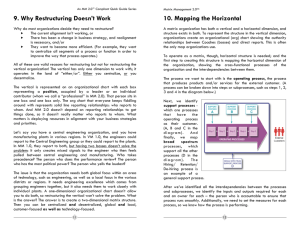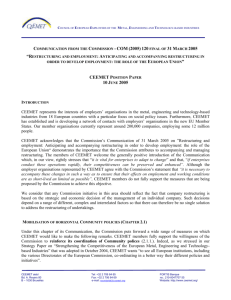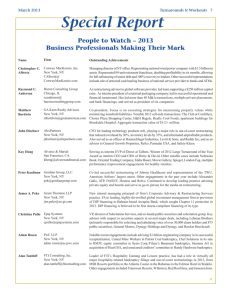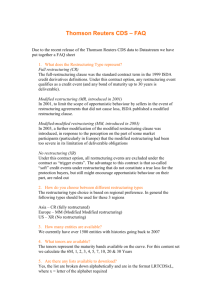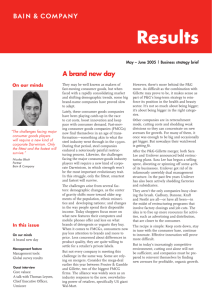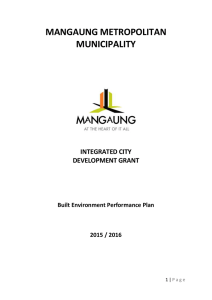Restructuring South African Cities
advertisement
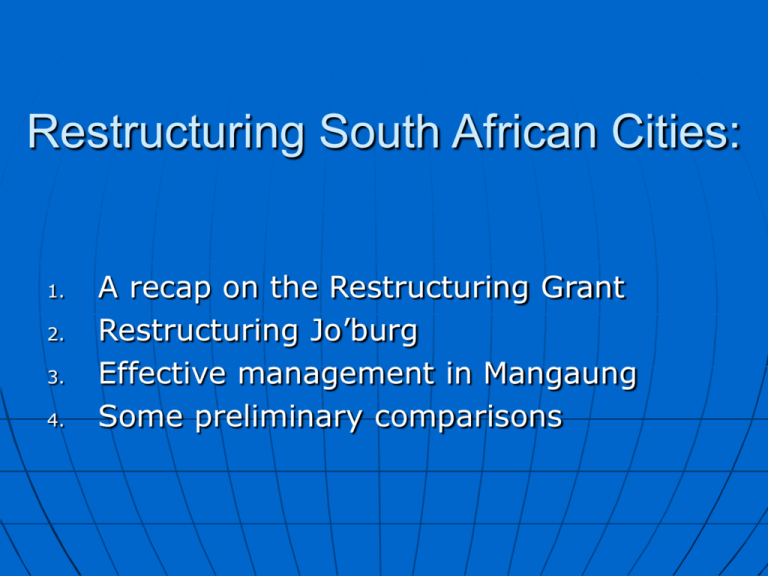
Restructuring South African Cities: 1. 2. 3. 4. A recap on the Restructuring Grant Restructuring Jo’burg Effective management in Mangaung Some preliminary comparisons What is the Restructuring Grant? Grant administered by National Treasury Aimed at approximately the largest 15 municipalities • Those whose success or failure would have an impact on the national economy Was developed in the context of a response to the Johannesburg crisis Intended to facilitate restructuring which • pre-empts and avoids key threats • Leads to significant enhancement of a municipality Characteristics of the grant Not intended to finance specific projects Aimed at getting municipalities to develop a coherent strategy and programme for improvement….and stick to it Structural reform programme to be determined by municipality – not Treasury Agreed amounts are paid out on the basis of reaching pre-agreed targets and milestones Aimed at developing a more substantial relationship between bigger cities and Treasury Amounts available are considerable Content of application Key motivation of about 10 to 15 pages • Annexures containing detail Must show proper appreciation and ownership of key issues and problems Must indicate strategies to address key problems and opportunities Must include indicators against which progress in addressing key problems can be measured • To be refined in the process of negotiations Emphasis on financial sustainability What are we looking for? An understanding of the current context and trends w.r.t. economic, social , service delivery, financial & organisational issues A vision and approach that addresses these issues that is credible, owned and understood by key leadership (political and administrative), and clearly communicated A set of lead programmes and projects which give life and momentum to the vision • • • • Limited number Appropriately balanced between inward and outward focus Milestones that can be monitored Aimed at supporting key drivers and managing key risks Must be based on financial sustainability & address revenue/income issues Restructuring Amalgamating Johannesburg Pre 1994 11 Administrations 1995 Elections 8 Councils City of Johannesburg Post elections 2000 The Need for Change Reality in 1999: a City in crisis •Financial crisis – expenditure control and revenue management •growing non-payment (debtors at 240 days, 42% of total income) •weakening revenue streams due to fragmented billing, service delivery and treasury functions •expensive structures (42 000 staff), esp middle mgmt •aggressive capital budget •large overdraft, zero surplus, abundant arrears •Low morale •No accountability •Poor customer service •Reduced service quality •Duplications •Fragmented Systems & Procedures SOLUTION An institutional restructuring programme with an efficiency objective: • clarifying roles and lines of accountability of legislature – executive – management – providers - residents • developing performance culture & incentives Strategy to redefine council structure • Polit- admin interface • Service provision:- from delivery to enablement • Stakeholder participation shifted towards more diffuse interests A new organisation designed Council Exec Mayor •City Power •Pikitup •JHB Water •Roads Agency •City Parks •JHB Zoo •Civic •The Market •Metrobus •ProCom CM Contracts Finance Corporate Community MPS Regions X 11 Heritage Services EMS Peoples Centres Health Social Services Housing Libraries The People Good governance Sustainable services Social & Economic Development Healthy and Safe Environment Participatory and Inclucivity Planning Sport & Recreation Political/ Admin Interface Structure Executive Mayor City Manager Speaker 109 Mayoral Committee Central Admin RM Council Section 79 Committees Regions The People’s Assembly 108 PR Ward 217 Regional Ward Offices Ward Committees Internal Organisational Structure Council Executive Mayor CEO Finance Corp. Service Comm. Dev Contr. Mangt Heritage EMS Plan Regions X 11 Health Social Services Housing Peoples Centres Libraries Sport & Recreation MPS Utilities and Agencies UTILITIES: (Dividend-paying) •Joburg Water, Citipower, Pikitup •AGENCIES (Subsidised) •Johannesburg Roads, City Parks CORPORATISED ENTITIES •The Civic Theatre, The Zoo, Metro Bus, Fresh Produce Market, Johannesburg Property Company, JDA, MTC Independent Boards, Service delivery agreements Privatisation, Corporatisation & Outsourcing Privatisation Corporatisation Outsourcing Rand Airport (June) S197 of the LRA facilitated transfer • Employee briefings and consultations extensive • All Contracts protect employee provisions and give job guarantee Metro gas Corporatisation IT outsourcing Fleet outsourcing (August) (July) (September) (October) Contract Management & Regulation Exec Mayor Shareholder Shareholders Unit CEO Contract Management Unit Consultants Accountant •Financial Analysis Economic •Tariffs •Pricing Policy Engineering legal •Quality •Service Delivery •Strategy Agreements •Busn’s plans •Governance The financial plan Weakly developed at first • Revenue not focused on, but • Condition of the Project (the financial outcome of iGoli 2002 plan), and of Restructuring Grant (R525m over 3 years) Realised that a financially stronger city can • • • • • • Build its own reserves Borrow at cheaper rates Achieve sound financial administration Achieve acceptable payment levels React to changes in payment levels Maintain assets and service levels Strategic Planning Cycle iGoli 2010 - long term and strategies 3 year rolling strategic plan & budget annual review cycle. Integral Part of the Strategic Planning Cycle This 3 year financial plan is being produced in a time of change. Revised as the transition process progresses 4 What did it mean ... As a resident…….. Participation Improved services Transparency Ongoing development of facilities Accountable local government Enhanced access As an employee... Greater role clarity Career development Plans for salary parity to be addressed Reskilling opportunities Working partnership Johannesburg Restructuring Grant Negotiated btw March and August 2000, based on iGoli 2002, providing R525 million over 3 years • Partnership btw central and local government Institutional conditions to ensure timely implementation of iGoli 2002 plan Financial conditions to address risks: • • • • • external debt management management of expenditure mix cash flow improvements enhanced and responsible capital spending revenue improvement City permitted to adjust financial trendline but not outcome Quarterly reporting required Progress in Jo’burg Still too early to tell, but: Greater political focus on governance and delivery More uniform and stable political centre Greater administrative confidence and capacity, within performance culture Vastly improved strategic capacity Consciously and successfully branded as a success Limited progress of revenue enhancement, but improved financial reporting and debt management through establishment of Budget Office Greater focus on economic development and job creation Service delivery improvements emerging from increased capital spending, and new service subsidies for poor Improvements in housing delivery, customer care and management of inner city Lessons from Jo’burg Although complex and time-consuming, it can be done Key success factor is local ownership of problems and solutions Strong political and admin leadership is necessary to take tough decisions A crisis provides significant momentum, by framing issues necessary for action Not necessarily accurate in complex systems Designing residual functions (including regulatory framework) is complex and difficult Credible, concrete and implementable programme is essential Never ignore revenue performance Branding is important Effective City Management in Mangaung (Bloemfontein / Botshabelo / ThabaNchu) Towards a strategic framework Situation analysis State of development • stagnant economy with evidence of decline • growing population - younger, poorer • large anticipated impact of HIV/AIDS State of services and finance • reasonably sound finances but signs of stress • significant basic service backlogs but manageable • development services poorly developed State of municipal organisation • reasonably solid administration but lots of improvement needed Service Protection 1994/5 16.7 2001/2 13.9 11.6 7.8 2.8 10.6 5.8 3.6 Engineering 8.8 11.1 Treasury 5.4 3.5 13.9 14.9 3.8 23.5 13.6 4.6 14.4 9.9 Parks Health HR Sanitation Sundry Urban Planning C\Sec Debt and provision for debt 350000000 300000000 250000000 200000000 150000000 100000000 50000000 Debtor Provision for bad debt 99/00 98/99 97/98 96/97 95/96 94/95 93/94 92/93 91/92 90/91 89/90 0 2 1.5 1% grow th 1 3% grow th 0.5 6% grow th Years 2011 2009 2007 2005 2003 0 2001 Size of econom y Implications of different growth rates of local economy What resources will be available to deliver services ten years from now? 6% growth 1% growth R1521m R935m R850m Now Ten years time 3 locational advantage 10 workforce skills 12 access to information and technology 13 land availability 21 redistribution marketing and incentives 16 poverty and unemployment 15 HIV/AIDS 2 crime rate 1 economic growth 7 community cohesion 8 common approach and programme 22 private investment 23 civic leadership 20 environment 5 municipal revenue 19 basic services provided 11 competitive tariffs 18 quality service delivery Our strategy for achieving this Virtuous circle of growth, community self-reliance and service excellence Community resilience & self-reliance Economic growth Civic Leadership Common purpose Service excellence Our strategy for achieving this Virtuous circle of growth, community resilience and self-reliance and service excellence Community resilience & self-reliance Economic growth Safety Income Civic Leadership Common purpose CBD Environment HIV/AIDS Housing Roads and water Service excellence Education Implementation Focus on key drivers Manage key risks Focus on key drivers “Mangaung on the Move” (growth initiative) • engage immediately with key potential investors (MDP) • CBD renewal “Community Power” (community support programme) • pilots for community service delivery • implementation of ward plans AIDS ACTION Service Charter 2006 • sustainable service levels • getting out of non-core business (engage MIIU) • service strategies for each service (waste management, community/development services) Focus on key drivers (cont) 100% Campaign (debt collection) • tax and tariff policy • re-organisation of income administration “The Benchmark Municipality” Municipal Reform programme • finalising organisation design and associated systems • responsiveness and customer care • performance management and benchmarks • efficient decision-making and administrative systems Manage key risks Turning around rising personnel cost trend • organisation restructuring to reduce over time total cost of employment Addressing disparities and challenges of BBT reality • short term measures work with FSDC to fill idle factories in Thaba Nchu and Botshabelo service extension as per agreed levels and standards • investigate longer term approaches long-term transport strategy investigation of Botshabelo EPZ • no major new infrastructure development until trends and strategies clearer? Manage key risks ‘Ahead of the RED’ • Responding pro-actively to creation of REDS • speedy movement to business unit understanding costs understand systems enhanced positioning • active lobbying at all levels to maximise municipal interest Enhancing position of Mangaung in inter-governmental system • active lobbying and networking for 1 effective tier (ideally metro status) Addressing the AIDS pandemic Lessons from Mangaung Well-managed authorities should not rest on their laurels Participatory processes can deliver high-quality and innovative results, while still making tough decisions Inter-governmental relationships are critical to manage proactively Strong leadership and clear communication are critical Comparisons Focus on the big picture, save detail for specific interventions Decisions required on level of integration • Mangaung a more typical CDS, but only a starting point to frame agenda, considerable work required on technical design • Jo’burg far more technically developed, less typical - reflects different motivations Leadership is critical • A small, committed team • Quick and deep decision-making essential • Change managers NOT crisis managers

